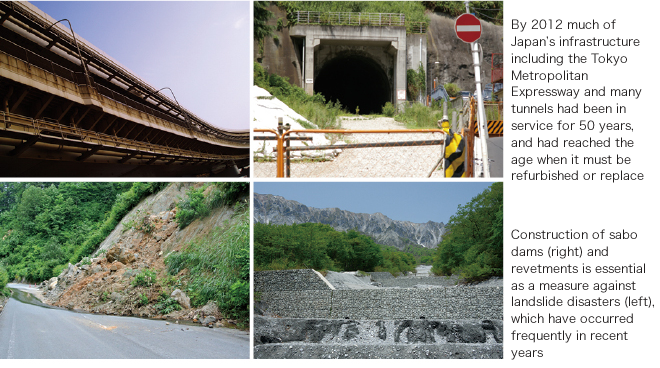Warning: include(/home/c9205967/public_html/kanamoto.ne.jp/include/menu_50annual_en.php): Failed to open stream: No such file or directory in /home/c9205967/public_html/kanamoto.ne.jp/en/pub/50/annualreport/06/index3.html on line 93
Warning: include(): Failed opening '/home/c9205967/public_html/kanamoto.ne.jp/include/menu_50annual_en.php' for inclusion (include_path='.:/opt/alt/php82/usr/share/pear:/opt/alt/php82/usr/share/php:/usr/share/pear:/usr/share/php') in /home/c9205967/public_html/kanamoto.ne.jp/en/pub/50/annualreport/06/index3.html on line 93
Feature|Sources and Foundation of Growth
Disaster Prevention and Mitigation Measures
Infrastructure maintenance and repair for national resilience
Public awareness concerning measures to address Japan's decaying infrastructure has been heightened by incidents such as the Great East Japan Earthquake and an accident involving the sudden fall of ceiling plates in an expressway tunnel. East Nippon Expressway Company (NEXCO) and other expressway operators have plans to invest several trillion yen over the next 10-15 years to repair Japan's expressways. Within just a few years, much of the infrastructure that was built during the concentrated burst of construction from the 1960s to the 1980s, including roads, railways, bridges, tunnels, dams, harbors and airports, will be 50 years old. This means Japan is facing a period of intensive renewal from 2010 through 2030. The rate of progress on these infrastructure maintenance projects remains slow, however, and the danger of a serious accident occurring if maintenance, repairs and upgrades are not undertaken appropriately in the future has been highlighted.
Measures to address the localized torrential rains that have occurred frequently in recent years have also taken on a new urgency. While Japanese cities such as Tokyo have underground flood control reservoirs to contain runoff when precipitation exceeds river flow capacity, many such facilities were designed on the premise of 50 milliliter per hour rainfall, and there is a possibility they cannot handle a localized torrential downpour in excess of 100 milliliters. Moreover, localized torrential rains in Hiroshima Prefecture in August 2014 resulted in a large-scale landslide disaster. Construction of facilities such as underground reservoirs, revetments, and sabo erosion dams are essential as countermeasures to cope with such circumstances. Based on such conditions, the government has approved the expenditure of an astounding 200 trillion yen for "national resilience". The Basic Plan for Extending the Lifespan of Infrastructure, which incorporates the aim of zero critical infrastructure accidents attributable to superannuation, is part of this effort as well, and public-works programs concerning infrastructure maintenance and repairs are already being implemented in various regions.
